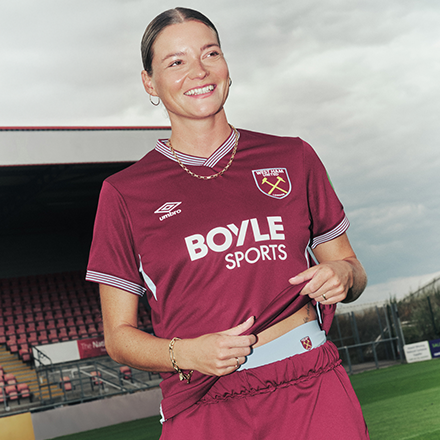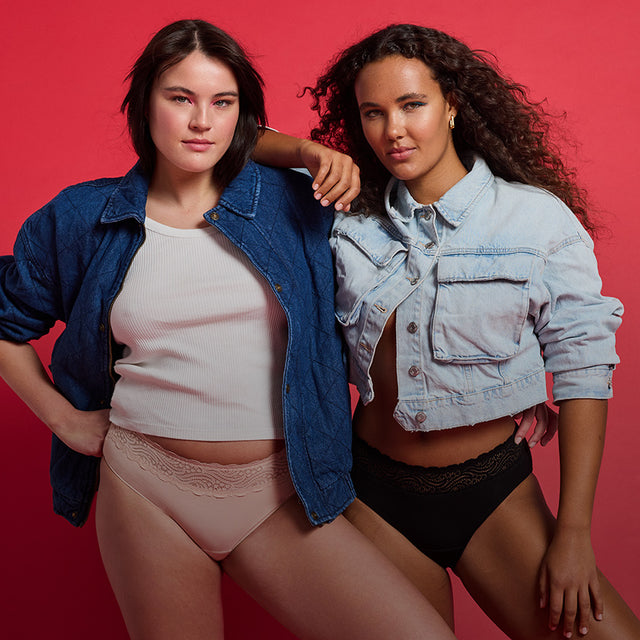Wenn es darum geht, während des Menstruationszyklus aktiv zu bleiben, stehen viele Frauen vor der Frage: „Wie kann ich trotz der körperlichen und hormonellen Veränderungen mein Trainingsprogramm beibehalten?“
Mit der richtigen Unterstützung ist es einfacher, während Ihres Zyklus aktiv zu bleiben – wie etwa mit der Modibodi x PUMA Periodenunterwäsche, die so konzipiert ist, dass sie sich Ihren Bewegungen anpasst und Sie bei jedem Training trocken hält.
Ich habe selbst Erfahrung damit – sowohl individuell als auch professionell in der Betreuung von Klienten. Hier sind meine Top-Tipps für die Verwaltung Ihres Trainings während Ihres Zyklus . Ob Sie an Ihrer Routine festhalten und Ihre Ziele im Auge behalten möchten oder ob Sie keine feste Routine haben: Welche Art von Training unterstützt Sie in jeder Phase am besten?
Bevor Sie sich auf die einzelnen Phasen und Tipps stürzen, betrachten Sie diese bitte als allgemeine Richtlinie. Das Energieniveau kann variieren und jeder Mensch ist anders. Deshalb empfehle ich Ihnen, Ihren Zyklus – zusammen mit Ihrem Energieniveau und anderen Symptomen – mit einer App zu verfolgen und die Vorschläge an das anzupassen, was für Ihren Körper am besten funktioniert und sich für Sie am besten anfühlt. Für medizinische Beratung wenden Sie sich bitte an Ihren Hausarzt oder Ihre Ärztin.
Verstehen Sie Ihren Menstruationszyklus und seine Auswirkungen auf die Fitness
Ihr Menstruationszyklus besteht aus vier Phasen: Menstruationsphase, Follikelphase, Eisprung und Lutealphase. Jede Phase bringt unterschiedliche hormonelle Veränderungen mit sich, die sich auf Ihr Energieniveau, Ihre Kraft und Ihre allgemeine Trainingsmotivation auswirken können. Bitte beachten Sie, dass die Dauer dieser Phasen je nach Länge Ihres individuellen Zyklus variieren kann.
Die Methode, die ich Ihnen hier vorstellen werde, wird oft als Zyklussynchronisation bezeichnet. Dabei geht es darum, Ihr Training an Ihren Zyklus anzupassen. So passen Sie Ihre Trainingsintensität an diese hormonellen Veränderungen an:
1. Menstruationsphase (Tage 1-5)
Was Sie erwartet: Tag 1 beginnt mit Ihrer Periode. Dies ist die Zeit, in der Ihr Körper die Gebärmutterschleimhaut abstößt, und Sie können Krämpfe, Müdigkeit und Stimmungsschwankungen erleben.
Trainingstipps
Passen Sie Ihre Intensität an: Konzentrieren Sie sich auf sanfte Aktivitäten wie Yoga, Spazierengehen oder sanftes Dehnen. Diese können Krämpfe lindern und Ihre Stimmung verbessern, ohne Sie zu überanstrengen. Wenn Sie sich ausgelaugt fühlen, ist es völlig in Ordnung, eine Pause einzulegen oder ein leichteres Training zu wählen. Ziel ist es, in Bewegung zu bleiben , ohne an Ihre Grenzen zu gehen.
Bleiben Sie auf Kurs: Nutzen Sie diese Zeit, um sich auf Erholungstechniken außerhalb Ihrer Routine zu konzentrieren, wie etwa Foam Rolling oder leichtes Dehnen, um die Flexibilität zu erhalten und Muskelkater zu reduzieren.
2. Follikelphase (Tage 6-14)
Was Sie erwartet: Der Östrogenspiegel steigt, was zu mehr Energie und Motivation führt.
Trainingstipps
Schwung aufbauen: Nutzen Sie diese Phase, um Ihr Training schrittweise zu steigern
Steigern Sie die Intensität und steigern Sie Ihre Höchstleistung. Konzentrieren Sie sich beim Krafttraining auf eine progressive Überlastung oder steigern Sie die Dauer Ihres Cardiotrainings schrittweise.
Zu den Trainingsmöglichkeiten in dieser Phase gehören Krafttraining, HIIT, Lauf- oder Radintervalle, Power-Yoga und Zirkeltraining.
Bleiben Sie am Ball: Setzen Sie sich neue Fitnessziele, die Sie bis zum Eisprung erreichen möchten. Fordern Sie sich beispielsweise heraus, jede Woche schwerere Gewichte zu heben oder Ihre Laufstrecke zu steigern. Das hilft Ihnen, motiviert zu bleiben und sich auf Ihre Fortschritte zu konzentrieren.
3. Eisprungphase (Tage 15-17)
Was Sie erwartet: Dies ist der Höhepunkt Ihres Östrogenspiegels, der oft durch erhöhte Kraft und Ausdauer gekennzeichnet ist.
Trainingstipps
Maximieren Sie Ihre Anstrengungen: Nutzen Sie Ihre Energiespitzen, indem Sie Ihre intensivsten Trainingseinheiten in diese Zeit legen. HIIT-Einheiten oder Wettkampfsport können besonders viel Spaß machen. Dies ist eine großartige Zeit für intensives Krafttraining, Sprintintervalle, Bootcamp-Kurse, Mannschaftssportarten oder meine persönlichen Lieblings -Radkurse!
Profi-Tipp: Trinken Sie ausreichend! Regelmäßige Flüssigkeitszufuhr ist entscheidend, aber in dieser Phase ist sie besonders wichtig, um Ihre Höchstleistung zu unterstützen.
Bleiben Sie am Ball: Nutzen Sie diese Phase, um sich in Gruppenkursen zu pushen. Der soziale Aspekt und der Coach können helfen , Motivation und Verantwortlichkeit aufrechtzuerhalten und sicherzustellen, dass Sie Ihr maximales Energieniveau optimal nutzen.
4. Lutealphase (Tage 18-28)
Was Sie erwarten können: Wenn der Progesteronspiegel steigt, können Sie sich müder fühlen und PMS-Symptome bekommen.
Trainingstipps
Hören Sie auf Ihren Körper: Möglicherweise stellen Sie fest, dass Ihre Energie nachlässt. Konzentrieren Sie sich daher auf moderates Training wie Pilates , leichtes Joggen oder Yoga. Gönnen Sie sich bei Bedarf ein paar Ruhetage.
Integrieren Sie Achtsamkeit: Dies ist eine großartige Zeit, um Achtsamkeit durch sanftes Yoga oder Meditation zu üben, was dabei helfen kann, Stress abzubauen und Ihren Körper auf den nächsten Zyklus vorzubereiten.
Tipp zum Durchhalten: Erstellen Sie einen flexiblen Trainingsplan, der sich je nach Tagesform an Ihre Fitness anpasst. Kontinuität ist in dieser Phase wichtiger als Intensität. Planen Sie Ihr Training auch mit Freunden, um die Einhaltung der Ziele zu gewährleisten.
Allgemeine Tipps für ein menstruationssicheres Training
Bleiben Sie bequem: Wählen Sie Trainingskleidung, in der Sie sich sicher und wohl fühlen. Während der Menstruationsphase (Tag 1-5) benutze ich meine Modibodi x PUMA nahtlose Periodenunterwäsche . Dadurch fühle ich mich während des Trainings sicher und trocken, sodass ich mich auf das Training konzentrieren kann, ohne mir Sorgen über Auslaufen machen zu müssen.
Nähren Sie Ihren Körper: Achten Sie auf Ihre Ernährung. Eine ausgewogene Ernährung mit viel Vollwertkost kann Ihr Energieniveau unterstützen und PMS-Symptome bekämpfen.
Du schaffst das!
Ihr Menstruationszyklus muss Ihr Fitnessprogramm nicht beeinträchtigen. Wenn Sie die verschiedenen Phasen und ihre Auswirkungen auf Ihren Körper verstehen, können Sie Ihr Training an Ihren Zyklus anpassen, anstatt dagegen. Mit diesen Tipps bleiben Sie aktiv, fühlen sich gestärkt und können den natürlichen Rhythmus Ihres Körpers annehmen.
Über den Autor
Alicia Portelli ist Fitnesstrainerin mit über neun Jahren Branchenerfahrung. Sie besitzt Zertifikate III und IV in Fitness und ist qualifizierte Personal Trainerin und Gruppenfitnesstrainerin. Alicia ist auf Rhythm Cycling spezialisiert und bietet einen dynamischen , inklusiven und motivierenden Trainingsstil . Ihr Herz schlägt dafür, Menschen zu helfen, zu wachsen und sich in ihrem Körper wohlzufühlen – sowohl im Studio als auch außerhalb.
Und wenn Sie weitere Kontakte knüpfen möchten, folgen Sie Alicia auf Instagram und TikTok .
Diese Informationen ersetzen keinen Arztbesuch . Bei medizinischen Fragen oder Bedenken wenden Sie sich bitte an einen Arzt.







